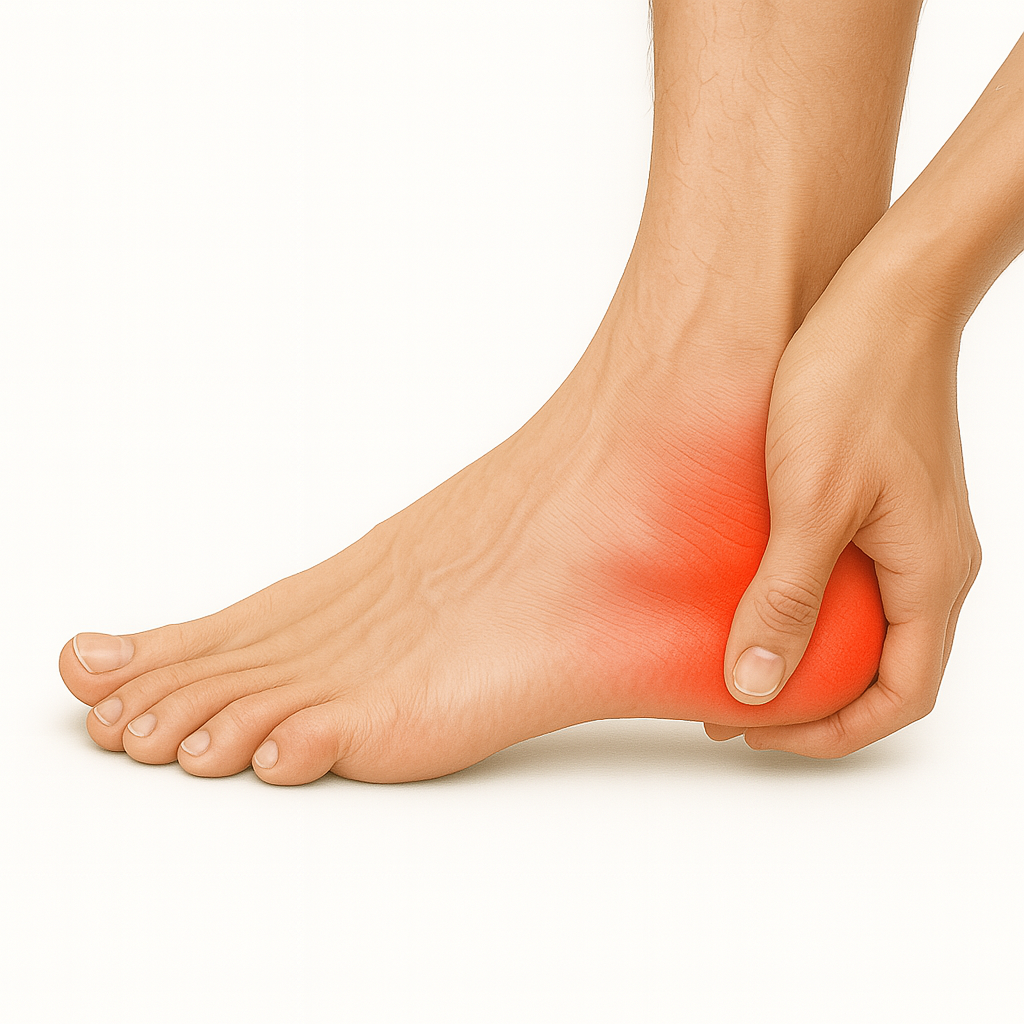Foot & Ankle Pain
Disclaimer: The information provided here is for educational purposes only and is not a substitute for professional medical advice, diagnosis, or treatment. Please consult your podiatrist for a comprehensive evaluation and personalized care.
Heel Pain
Are you ready to take on the day only to feel sharp pain with your very first step out of bed? Did you know that one of the most common causes of heel pain is plantar fasciitis?
-
Plantar Fasciitis (pronounced plan-ter fash-ee-eye-tis): Inflammation and swelling of a thick band of tissue located across the bottom of the foot. The plantar fascia connects the heel bone to the base of the toes.
Achilles tendinitis: irritation of the tendon at the back of your heel.
Other causes: heel spurs, bursitis, stress fracture, or nerve entrapment, overuse, being overweight, wearing shoes that lack adequate support
-
Try This at Home:
Rest, ice your heel, stretch your calves and arches, wear supportive shoes, and take over-the-counter pain relievers if needed.If your pain gets worse or doesn’t improve after two weeks, let us help. Once Dr. Doan find the cause of your heel pain, she’ll work with you to create a personalized treatment plan.
Bunions
-
Wearing tight, narrow, or high-heeled shoes
Genetics
Flat feet or abnormal walking mechanics
Arthritis or joint damage
-
Try This at Home:
Try wearing wider shoes, padding the bump, and taking over-the-counter pain relieversWhen you visit our office, we’ll start with a careful exam of your foot and may take X-rays to see how your toes are aligned. This also helps us rule out other conditions, like arthritis or gout, that can cause big toe pain.
Depending on your symptoms and goals, we offer a range of treatment options: Custom orthotics, Padding & taping, steroid injection, physical therapy.
If conservative treatments don’t bring enough relief, we can discuss surgery to realign the toe and restore comfort.
-
Are bunions always painful?
Not always. Some bunions cause little or no pain at first, but they can get worse over time if left untreated.Do bunions go away on their own?
No. Bunions are progressive and won’t go away without treatment. Early care can help slow their progression and relieve symptoms.Can I prevent a bunion from getting worse?
Wearing supportive shoes, using orthotics, and avoiding tight, narrow footwear can help slow the progression and reduce discomfort. Look for wide-toe box shoes with good arch support and cushioning to reduce pressure on the bunion.Do all bunions need surgery?
No. Many people find relief with non-surgical treatments, and surgery is usually only needed if conservative care fails.What happens during bunion surgery?
Bunion surgery is usually done as an outpatient procedure, so you can go home the same day. You’ll be sedated and your foot will be numbed. Your doctor will make small incisions near the bunion, then cut and realign the bones to restore proper alignment. The exact technique depends on the severity of your bunion.How long is the recovery after bunion surgery?
- First 6 weeks: limit weight-bearing on your foot, keep it elevated, and wear a surgical shoe or boot.
- 6–12 weeks: Gradually increase activity as your foot heals, guided by your doctor.
- 3–6 months: Most people can return to normal daily activities, but full recovery, including swelling and stiffness resolving, can take up to 6 months or longer.Is recovery from bunion surgery painful?
Yes. Some discomfort is normal as you heal, but your podiatrist will prescribe medications to help manage pain.
Bunions are progressive foot deformities that cause your big toe to lean toward the others, forming a bony bump at the base of the toe that can become painful over time.
Hammertoes
A hammertoe is when one or more toes become bent or curled, making it hard and painful to wear shoes or walk comfortably. We offer both conservative treatments, like padding, splints, and custom orthotics, and surgical options when needed to straighten your toes and relieve pain.
-
Arthritis, heredity and old age, most often they can be traced back to poor shoe choices.
-
Try This at Home:
Padding & splints, roomy and supportive shoes, toe exercises & stretching, over the counter anti-inflammatory medicationsIf your hammertoe is becoming stiff or more painful, don’t wait! Schedule a visit today to explore treatment options and get the relief you deserve.
Injury & Fracture Care
Foot and ankle injuries are common and can happen from falls, sports, overuse, or accidents. Fractures (broken bones) may cause pain, swelling, bruising, and difficulty walking.
Treatment depends on the severity of the injury and may include rest, ice, immobilization (like a boot or cast), physical therapy, or, in severe cases, surgery.
Proper care is key to healing correctly and getting back on your feet. Immediately after an injury apply the RICE treatment: Rest, Ice, Compression, and Elevation. You should see your podiatrist as soon as possible for evaluation.



